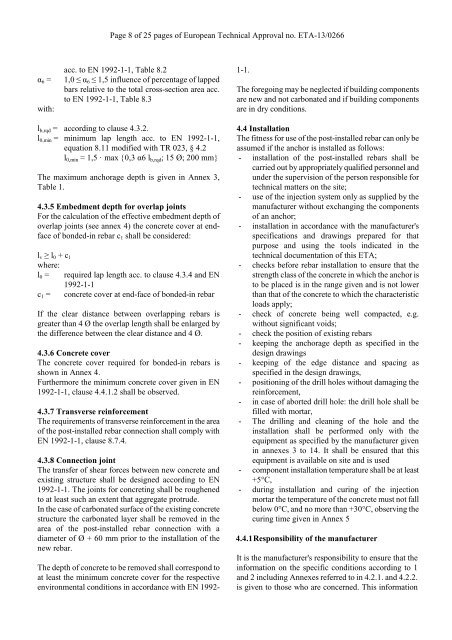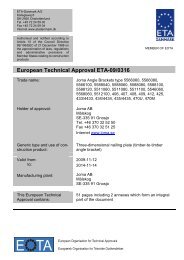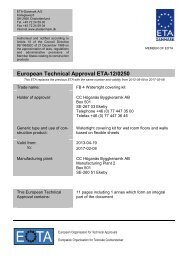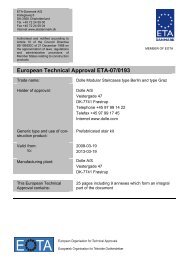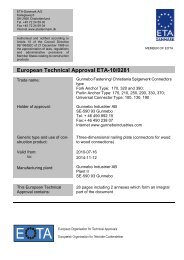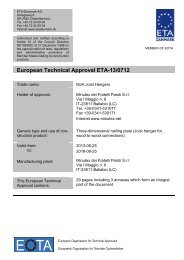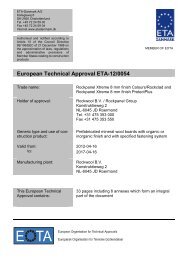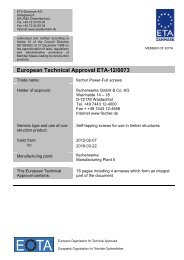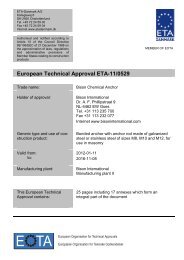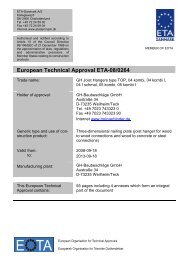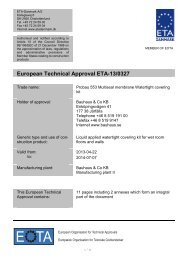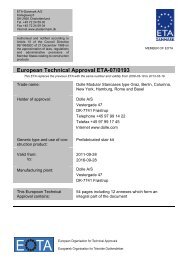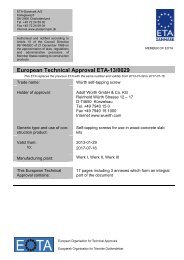ETA130266 HB ERSF CE Rebar - ETA-Danmark
ETA130266 HB ERSF CE Rebar - ETA-Danmark
ETA130266 HB ERSF CE Rebar - ETA-Danmark
You also want an ePaper? Increase the reach of your titles
YUMPU automatically turns print PDFs into web optimized ePapers that Google loves.
Page 8 of 25 pages of European Technical Approval no. <strong>ETA</strong>-13/0266<br />
acc. to EN 1992-1-1, Table 8.2<br />
α6 = 1,0 ≤ α6 ≤ 1,5 influence of percentage of lapped<br />
bars relative to the total cross-section area acc.<br />
to EN 1992-1-1, Table 8.3<br />
with:<br />
lb,rqd = according to clause 4.3.2.<br />
l0,min = minimum lap length acc. to EN 1992-1-1,<br />
equation 8.11 modified with TR 023, § 4.2<br />
l0,min = 1,5 · max {0,3 α6 lb,rqd; 15 Ø; 200 mm}<br />
The maximum anchorage depth is given in Annex 3,<br />
Table 1.<br />
4.3.5 Embedment depth for overlap joints<br />
For the calculation of the effective embedment depth of<br />
overlap joints (see annex 4) the concrete cover at endface<br />
of bonded-in rebar c1 shall be considered:<br />
lv ≥ l0 + c1<br />
where:<br />
l0 = required lap length acc. to clause 4.3.4 and EN<br />
1992-1-1<br />
c1 = concrete cover at end-face of bonded-in rebar<br />
If the clear distance between overlapping rebars is<br />
greater than 4 Ø the overlap length shall be enlarged by<br />
the difference between the clear distance and 4 Ø.<br />
4.3.6 Concrete cover<br />
The concrete cover required for bonded-in rebars is<br />
shown in Annex 4.<br />
Furthermore the minimum concrete cover given in EN<br />
1992-1-1, clause 4.4.1.2 shall be observed.<br />
4.3.7 Transverse reinforcement<br />
The requirements of transverse reinforcement in the area<br />
of the post-installed rebar connection shall comply with<br />
EN 1992-1-1, clause 8.7.4.<br />
4.3.8 Connection joint<br />
The transfer of shear forces between new concrete and<br />
existing structure shall be designed according to EN<br />
1992-1-1. The joints for concreting shall be roughened<br />
to at least such an extent that aggregate protrude.<br />
In the case of carbonated surface of the existing concrete<br />
structure the carbonated layer shall be removed in the<br />
area of the post-installed rebar connection with a<br />
diameter of Ø + 60 mm prior to the installation of the<br />
new rebar.<br />
The depth of concrete to be removed shall correspond to<br />
at least the minimum concrete cover for the respective<br />
environmental conditions in accordance with EN 1992-<br />
1-1.<br />
The foregoing may be neglected if building components<br />
are new and not carbonated and if building components<br />
are in dry conditions.<br />
4.4 Installation<br />
The fitness for use of the post-installed rebar can only be<br />
assumed if the anchor is installed as follows:<br />
- installation of the post-installed rebars shall be<br />
carried out by appropriately qualified personnel and<br />
under the supervision of the person responsible for<br />
technical matters on the site;<br />
- use of the injection system only as supplied by the<br />
manufacturer without exchanging the components<br />
of an anchor;<br />
- installation in accordance with the manufacturer's<br />
specifications and drawings prepared for that<br />
purpose and using the tools indicated in the<br />
technical documentation of this <strong>ETA</strong>;<br />
- checks before rebar installation to ensure that the<br />
strength class of the concrete in which the anchor is<br />
to be placed is in the range given and is not lower<br />
than that of the concrete to which the characteristic<br />
loads apply;<br />
- check of concrete being well compacted, e.g.<br />
without significant voids;<br />
- check the position of existing rebars<br />
- keeping the anchorage depth as specified in the<br />
design drawings<br />
- keeping of the edge distance and spacing as<br />
specified in the design drawings,<br />
- positioning of the drill holes without damaging the<br />
reinforcement,<br />
- in case of aborted drill hole: the drill hole shall be<br />
filled with mortar,<br />
- The drilling and cleaning of the hole and the<br />
installation shall be performed only with the<br />
equipment as specified by the manufacturer given<br />
in annexes 3 to 14. It shall be ensured that this<br />
equipment is available on site and is used<br />
- component installation temperature shall be at least<br />
+5°C,<br />
- during installation and curing of the injection<br />
mortar the temperature of the concrete must not fall<br />
below 0°C, and no more than +30°C, observing the<br />
curing time given in Annex 5<br />
4.4.1 Responsibility of the manufacturer<br />
It is the manufacturer's responsibility to ensure that the<br />
information on the specific conditions according to 1<br />
and 2 including Annexes referred to in 4.2.1. and 4.2.2.<br />
is given to those who are concerned. This information


